Abstract
The incidence of tolerance and paradoxical response to bactericidal activity of penicillin was investigated in 50 clinical isolates of Enterococcus faecalis. Of the isolates tested, 86% exhibited the paradoxical phenomenon whereby there were more survivors at high than at low concentrations above the MIC. Low penicillin concentrations caused decreases equal to or higher than 99.9% in 11 strains, from 99.9 to 99.5% in 23 strains, and lower than 99.5% in 9 strains. Of the total strains, 14% were killed to the same extent by all concentrations above the MIC. The bactericidal activities of other beta-lactams (ampicillin and piperacillin) and other cell wall inhibitors (vancomycin and daptomycin) were also tested against some of these strains. In general, beta-lactams exhibited the best bactericidal activity at 2 x MIC. Piperacillin was the most active, as at 2 x MIC it reduced the original inoculum by 99.9% or more in most of the strains. No concentration of vancomycin above the MIC caused 99.9% killing of the strains, whereas daptomycin was bactericidal at 8 x MIC in most cases. Paradoxical response to bactericidal activity of beta-lactams was abolished by incubation of the inoculum with 2 x MIC before exposure to higher antibiotic concentrations. These findings suggest that enterococci are not always tolerant to cell wall-active antibiotics and that accurate in vitro bactericidal tests may be useful for the choice of appropriate therapy for infections caused by these microorganisms.
Full text
PDF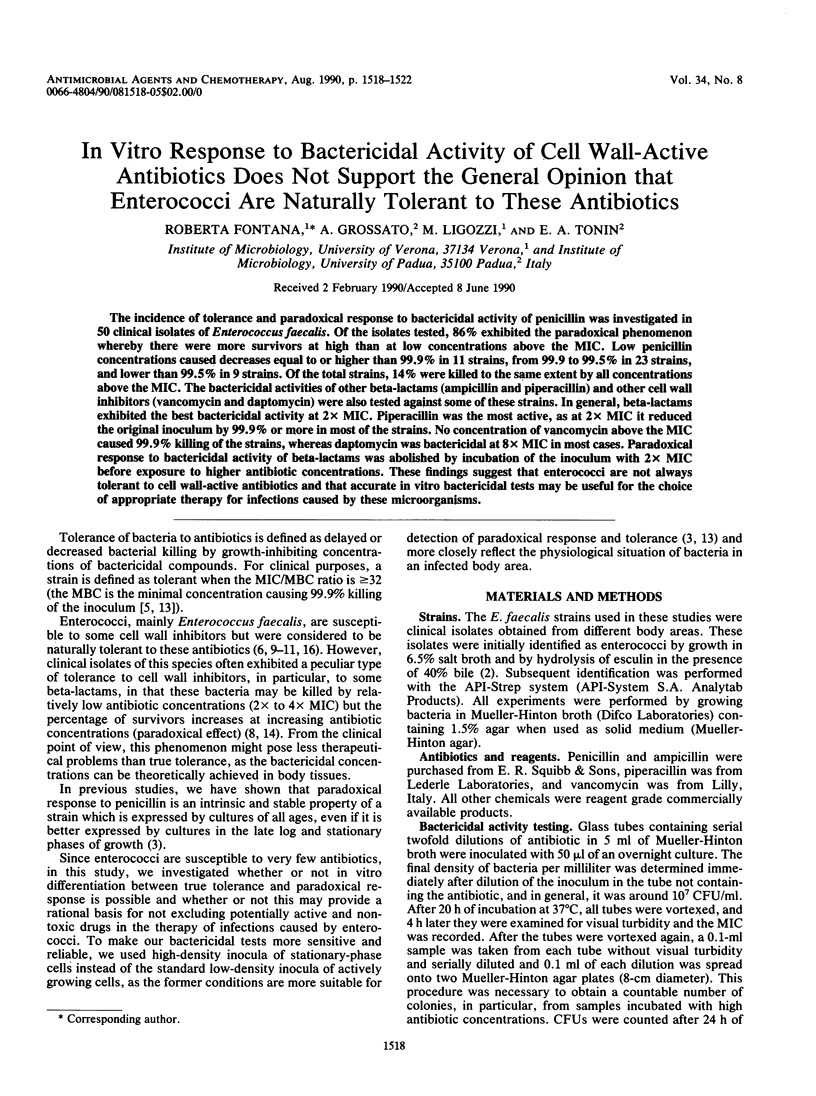
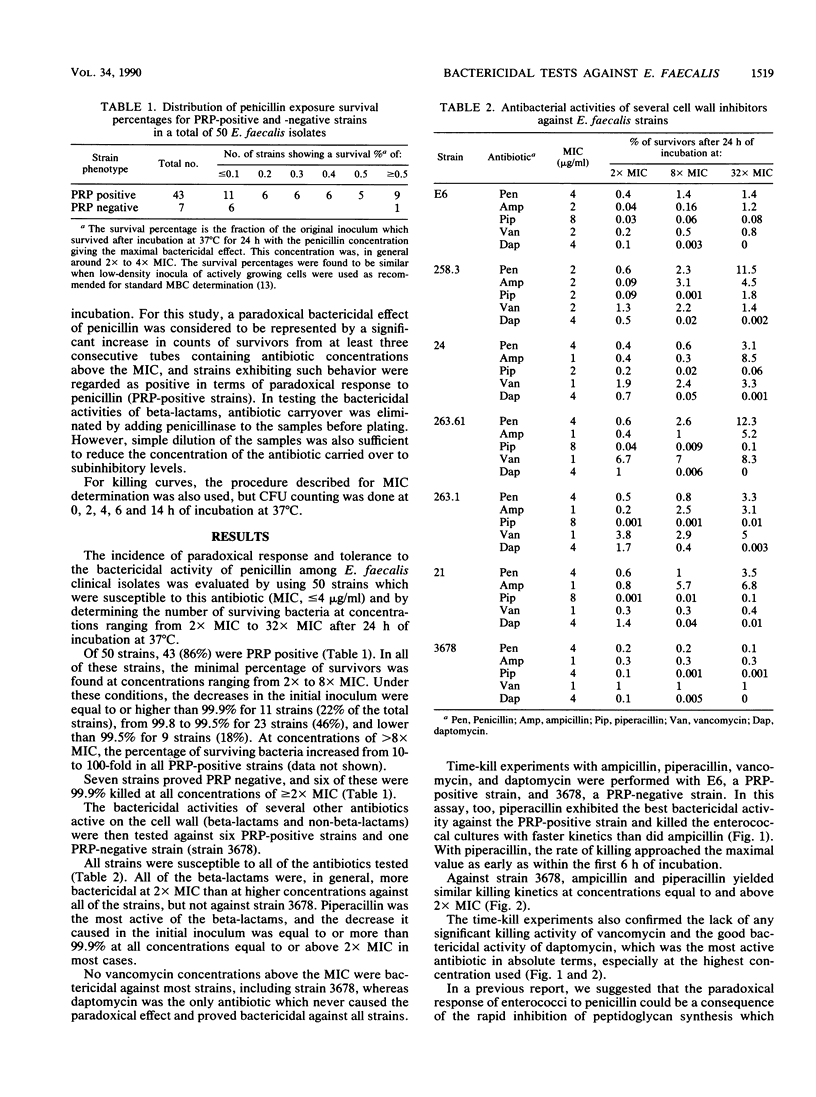
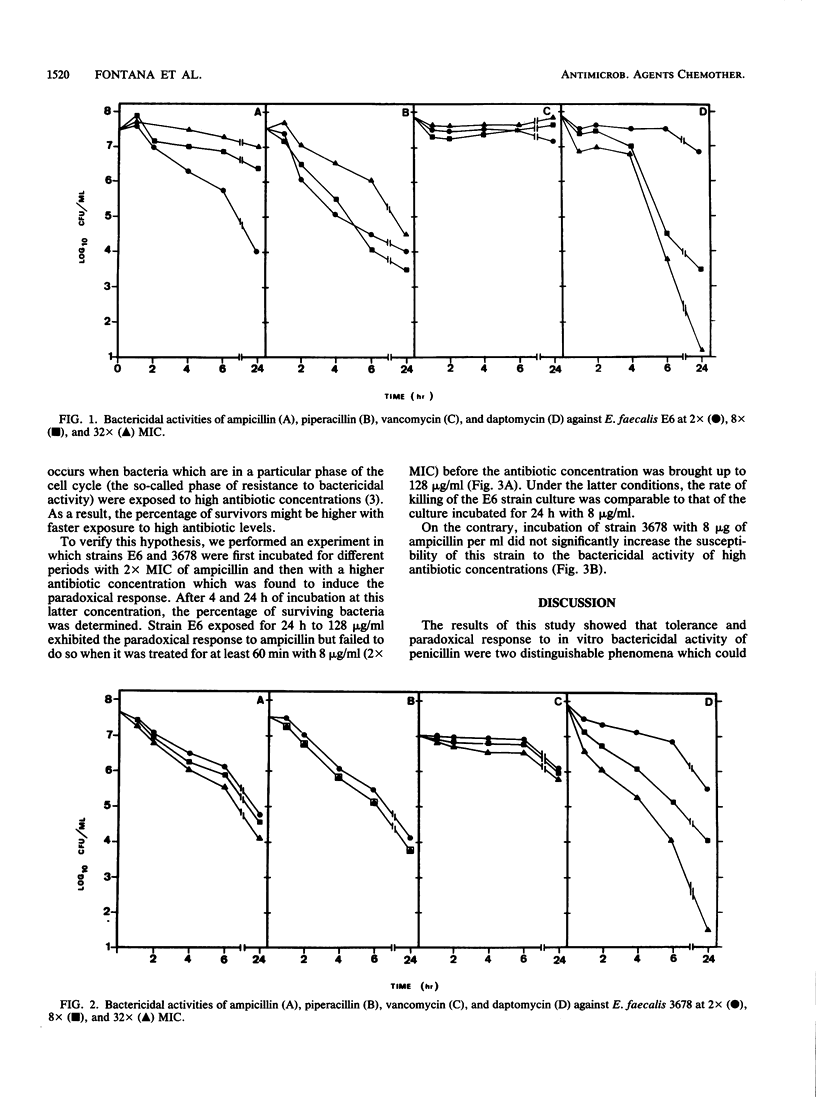
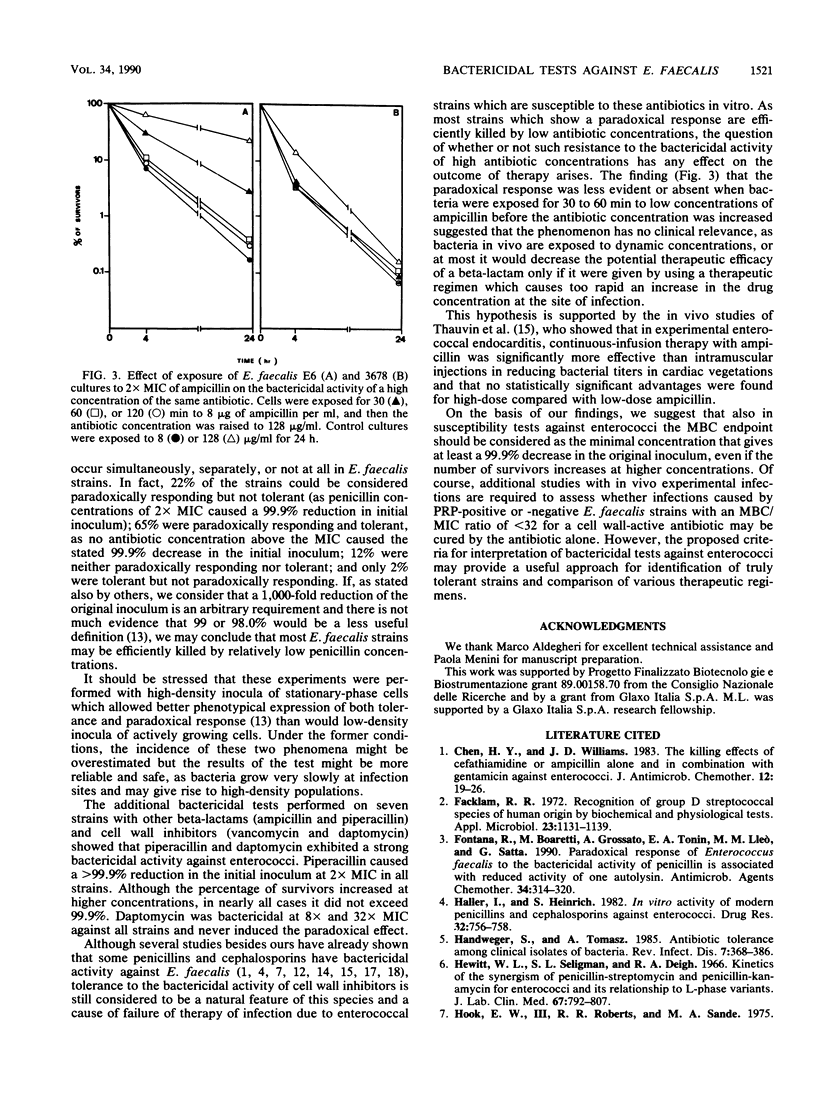
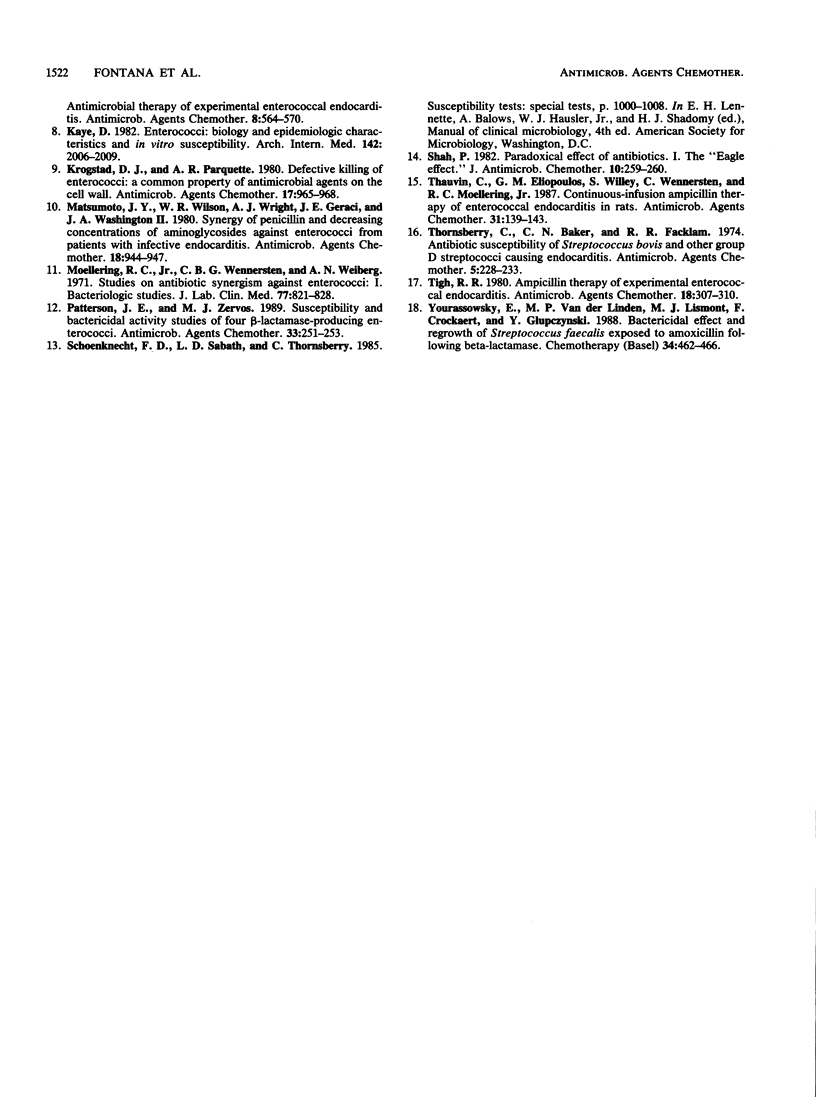
Selected References
These references are in PubMed. This may not be the complete list of references from this article.
- Chen H. Y., Williams J. D. The killing effects of cefathiamidine or ampicillin alone and in combination with gentamicin against enterococci. J Antimicrob Chemother. 1983 Jul;12(1):19–26. doi: 10.1093/jac/12.1.19. [DOI] [PubMed] [Google Scholar]
- Facklam R. R. Recognition of group D streptococcal species of human origin by biochemical and physiological tests. Appl Microbiol. 1972 Jun;23(6):1131–1139. doi: 10.1128/am.23.6.1131-1139.1972. [DOI] [PMC free article] [PubMed] [Google Scholar]
- Fontana R., Boaretti M., Grossato A., Tonin E. A., Lleò M. M., Satta G. Paradoxical response of Enterococcus faecalis to the bactericidal activity of penicillin is associated with reduced activity of one autolysin. Antimicrob Agents Chemother. 1990 Feb;34(2):314–320. doi: 10.1128/aac.34.2.314. [DOI] [PMC free article] [PubMed] [Google Scholar]
- Haller I., Heinrich S. In vitro activity of modern penicillins and cephalosporins against enterococci. Arzneimittelforschung. 1982;32(7):756–759. [PubMed] [Google Scholar]
- Handwerger S., Tomasz A. Antibiotic tolerance among clinical isolates of bacteria. Rev Infect Dis. 1985 May-Jun;7(3):368–386. doi: 10.1093/clinids/7.3.368. [DOI] [PubMed] [Google Scholar]
- Hewitt W. L., Seligman S. J., Deigh R. A. Kinetics of the synergism of penicillin-streptomycin and penicillin-kanamycin for enterococci and its relationship to L-phase variants. J Lab Clin Med. 1966 May;67(5):792–807. [PubMed] [Google Scholar]
- Kaye D. Enterococci. Biologic and epidemiologic characteristics and in vitro susceptibility. Arch Intern Med. 1982 Oct 25;142(11):2006–2009. doi: 10.1001/archinte.142.11.2006. [DOI] [PubMed] [Google Scholar]
- Krogstad D. J., Pargwette A. R. Defective killing of enterococci: a common property of antimicrobial agents acting on the cell wall. Antimicrob Agents Chemother. 1980 Jun;17(6):965–968. doi: 10.1128/aac.17.6.965. [DOI] [PMC free article] [PubMed] [Google Scholar]
- Matsumoto J. Y., Wilson W. R., Wright A. J., Geraci J. E., Washington J. A., 2nd Synergy of penicillin and decreasing concentration of aminoglycosides against enterococci from patients with infective endocarditis. Antimicrob Agents Chemother. 1980 Dec;18(6):944–947. doi: 10.1128/aac.18.6.944. [DOI] [PMC free article] [PubMed] [Google Scholar]
- Moellering R. C., Jr, Wennersten C., Weinberg A. N. Studies on antibiotic synergism against enterococci. I. Bacteriologic studies. J Lab Clin Med. 1971 May;77(5):821–828. [PubMed] [Google Scholar]
- Patterson J. E., Zervos M. J. Susceptibility and bactericidal activity studies of four beta-lactamase-producing enterococci. Antimicrob Agents Chemother. 1989 Feb;33(2):251–253. doi: 10.1128/aac.33.2.251. [DOI] [PMC free article] [PubMed] [Google Scholar]
- Shah P. M. Paradoxical effect of antibiotics. I. The 'Eagle effect'. J Antimicrob Chemother. 1982 Oct;10(4):259–260. doi: 10.1093/jac/10.4.259. [DOI] [PubMed] [Google Scholar]
- Thauvin C., Eliopoulos G. M., Willey S., Wennersten C., Moellering R. C., Jr Continuous-infusion ampicillin therapy of enterococcal endocarditis in rats. Antimicrob Agents Chemother. 1987 Feb;31(2):139–143. doi: 10.1128/aac.31.2.139. [DOI] [PMC free article] [PubMed] [Google Scholar]
- Thornsberry C., Baker C. N., Facklam R. R. Antibiotic susceptibility of Streptococcus bovis and other group D streptococci causing endocarditis. Antimicrob Agents Chemother. 1974 Mar;5(3):228–233. doi: 10.1128/aac.5.3.228. [DOI] [PMC free article] [PubMed] [Google Scholar]
- Tight R. R. Ampicillin therapy of experimental enterococcal endocarditis. Antimicrob Agents Chemother. 1980 Aug;18(2):307–310. doi: 10.1128/aac.18.2.307. [DOI] [PMC free article] [PubMed] [Google Scholar]
- Yourassowsky E., Van der Linden M. P., Lismont M. J., Crockaert F., Glupczynski Y. Bactericidal effect and regrowth of Streptococcus faecalis exposed to amoxicillin following beta-lactamase. Chemotherapy. 1988;34(6):462–466. doi: 10.1159/000238609. [DOI] [PubMed] [Google Scholar]


